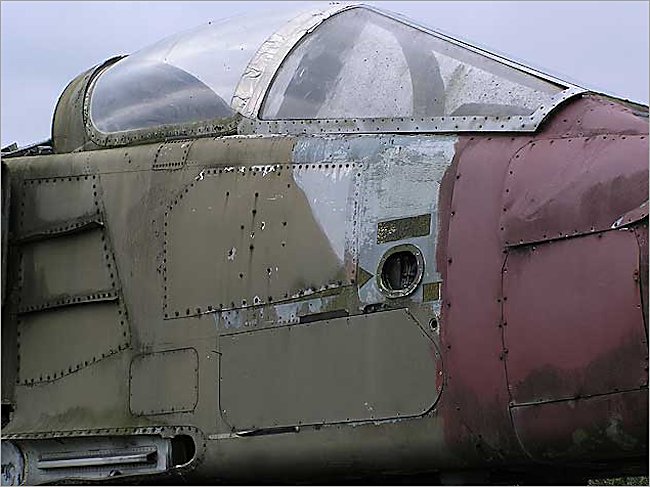RAF Jaguar GR1
The very sad looking Gatwick Jaguar XX734 arrived as a virtual "Hulk" and has had little or no attention given to it. It has been used to conduct explosive damage and battle damage repair. It has also had at least one cockpit fire. There are large holes and pieces of the airframe missing. XX734 was stored for some while on its belly and shows the signs. It is almost irrecoverable unless some components can be found for it. This aircraft first flew on the 5th of August 1974, it was loaned to the Indian Air Force in 1980 as an iterim measure before they received their aircraft. It was serialed JI014 whilst operating with the Indian Air Force. The museum is looking for volunteers to help restore this Jag. If you can help this classic British jet please call: Peter Vallance on 01293 862915.
The SEPECAT Jaguar is an Anglo-French Cold War ground attack jet fighter still in service with several export customers, notably the Indian Air Force and the Royal Air Force of Oman. It was among the first major Anglo-French military aircraft programs. The aircraft served as one of the French Air Force's main strike/attack aircraft until 1 July 2005 when it was replaced by the Dassault Rafale and with the Royal Air Force until the end of April 2007 when it was replaced by the RAF Eurofighter Typhoon. In the early 1960's the RAF wanted a replacement for the Hawker Hunter T7 and F-4 Phantom that had short take off ability and capable to supply close ground support for troops fighting off advancing Soviet armored brigades. The Jaguar had a maximum speed of 1,593 km/h, 1055 mph (Mach 1.6) and a range of 535 km (335 miles). Its service ceiling was 14,000 m (46,000 ft)

Photograph taken at the Gatwick Aircraft Museum next to Gatwick Airport Sussex England
The Jaguar armament included two 30 mm (1.18 in) ADEN cannons or DEFA cannons, 150 rounds/gun. It had five hard points onto which various weapons systems could be fitted. These included 8 Matra rocket pods with 18 SNEB 68 mm rockets each, Anglo-French AS-37 Martel missiles anti radar missiles, AN/ALQ-101 ECM protection pod (found only on RAF's Jaguar GR.3/3A), Joint Reconnaissance Pod, external drop tanks for extended range/loitering time, two over wing AIM-9 Sidewinders or Matra R550 Magics on overwing pylons (Jaguar International and RAF Jaguars only) and a variety of bombs.
Cross-channel negotiations with the French who were also in the market for a new aircraft led to the formation of SEPECAT in 1966 as a joint venture between Breguet, now Dassault Aviation, and the British Aircraft Corporation to produce the airframe, and a separate teaming of Rolls-Royce and Turbomeca to develop the Adour afterburning turbofan engine.

Photograph taken at the Gatwick Aircraft Museum next to Gatwick Airport Sussex England
The Jaguar has a long sleek fuselage with a large swept tail fin and rudder. The fuselage features a long, pointed, chiseled nose, and the body widens at the air intakes rectangular to the exhausts. Relatively short-span swept wings are shoulder-mounted on the fuselage. The internal jet engines, mounted to the rear of the cockpit, have rectangular air intakes either side of the fuselage behind the cockpit, with their top surfaces forming an extension of the wing. The engine exhausts show prominently under the forward portion of the tail. The rear jetpipes are located forward and below the tailplane which has marked anhedral. The raised bubble canopy is set above the sharply-pointed nose. The twin mainwheels of the undercarriage retract into the fuselage.
The RAF accepted delivery of the first of 165 single-seat Jaguar GR1s (or Jaguar S) with 54(F) squadron in 1974. These were supplemented by 35 two-seat trainers, the Jaguar T2 (or Jaguar B according to the manufacturer's designation). The Jaguar S and B had a more comprehensive nav/attack system than the A and E models used by the Armee de l'Air, and had the British Aden cannons installed instead of French DEFA cannons.

Photograph taken at the Gatwick Aircraft Museum next to Gatwick Airport Sussex England
At its peak in the strike role, the Jaguar was the backbone of RAF tactical strike capability in Central Europe, comprising four tactical nuclear strike squadrons, three conventional tactical strike squadrons, and a tactical reconnaissance squadron. The Jaguars began to be partly displaced by the Panavia Tornado in the mid-1980s, which took over roles such as nuclear strike, but the Jaguar still remained in frontline service.
RAF Jaguars proved their worth in the Gulf War in 1991. They were painted in desert pink (actually sand) color scheme. Over 600 combat sorties were performed by RAF Jaguars during the active air war, roughly the same number as the French AdA Jaguar sorties. They often carried CRV7 70mm unguided rocket pods, as well US-built CBU-87 cluster bomb units, though since these were longer than the traditional British BL755 cluster bombs only one could be fitted on a pylon; two BL755s could be carried in tandem. No air-to-air kills were scored as most of the oppositions air force were destroyed on the ground or escaped into Iran. RAF Jaguars served in helping police the "no fly zones" set up in Iraq, as well as in the various policing actions in the Balkans during the 1990s.
For News and information on visiting the Gatwick Aviation Museum go to their website at www.gatwick-aviation-museum.co.uk